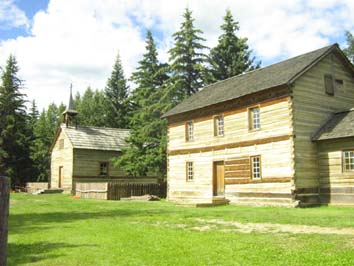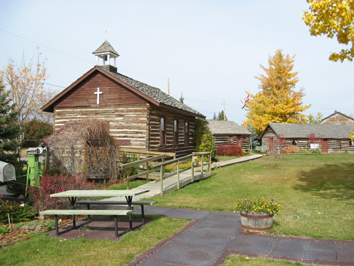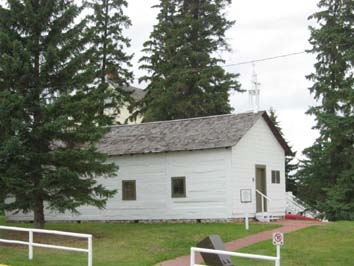
a solo exhibition by Simon Wroot
Three Historic Churches, restored
St. Albert
Father Lacombe’s Chapel, 1861
Father Albert Lacombe of the ‘Oblates of Mary Immaculate’ was one of Alberta’s best known missionaries. His work among the Indian tribes earned him the names “The Black Robe” and “the Beautiful Soul” by the Cree, and ”The Man with the Good Heart” by the Blackfoot.
|
|
While travelling together in 1861, Fr. Albert Lacombe convinced Bishop Tache that a mission should be established to serve the Blackfoot and Cree, as well as the Metis of the area. Bishop Tache agreed, planting a small sapling in the snow declared that “the site of the new mission...shall be called by the name of your Holy Patron, St. Albert.” The first building in St. Albert was the modest Log chapel, built of local timber by the Metis, some of the 70 families then in the district. In 1868, with the arrival of Bishop Grandin, the little building served as a cathedral for 2 years until replaced with a much larger building. In 1871 the roof was raised 2 feet, and a wooden floor was installed. It gradually deteriorated until 1929 when the chapel underwent it’s first restoration, when it was enclosed within a brick structure and served as a Father Lacombe museum. Being enclosed actually increased the rate of rot in the logs, in 1977 it was declared a Provincial Historic Resource, and in 1980 it was moved to it’s current location. It was completely restored to appear as it might have when it served as a church in the 1860s.
Although it has been disassembled, moved and restored the chapel remains the oldest known standing structure in Alberta
Dunvegan
St. Charles Mission Church, 1885
The Northwest Company had a trading post at Dunvegan in 1805, which soon became a Hudson Bay Company post. The Mission to the local First Nations and Metis people was founded in 1869 by the Oblate Fathers in a small house chapel. In the fall of 1883 the two resident priests, Fathers Grouard and Husson, felled the trees needed for a church and rafted them down the Peace River to the construction site. They spent the following winter squaring and sawing the logs and completed some of the assembly in the summer of 1884. Broad-axe marks on it’s timbers, the mortising and dowelling are evidence of patience and craftsmanship of the Metis volunteers. Slow drying timber delayed the completion of the church until 1885. By 1891, the Beavers, original inhabitants of the country, had largely died out and the Mission was closed and transferred to St. Augustine’s in the Shaftesbury Settlement, and then in to Spirit River, and Dunvegan received only occasional visits. After 1919 it became virtually deserted, being used in the 20s as a freighter’s house, as the ferry-man’s house, and in the 1940’s.as a convenience store and gas station. In 1951 local service clubs worked to preserve it, in 1956 the area became a Provincial Park. In 1957-1961 it was disassembled and re-built using all but a few of the original logs, those that had been cut out for the store window had been lovingly kept in the roof, and were re-used. It is now completely restored and operated by the Province of Alberta as a Historic Site, where it continues to tell the stories of the commitment of the Oblate missionaries and the hopes of the people who swung the axes to build it.
Nations and Metis people was founded in 1869 by the Oblate Fathers in a small house chapel. In the fall of 1883 the two resident priests, Fathers Grouard and Husson, felled the trees needed for a church and rafted them down the Peace River to the construction site. They spent the following winter squaring and sawing the logs and completed some of the assembly in the summer of 1884. Broad-axe marks on it’s timbers, the mortising and dowelling are evidence of patience and craftsmanship of the Metis volunteers. Slow drying timber delayed the completion of the church until 1885. By 1891, the Beavers, original inhabitants of the country, had largely died out and the Mission was closed and transferred to St. Augustine’s in the Shaftesbury Settlement, and then in to Spirit River, and Dunvegan received only occasional visits. After 1919 it became virtually deserted, being used in the 20s as a freighter’s house, as the ferry-man’s house, and in the 1940’s.as a convenience store and gas station. In 1951 local service clubs worked to preserve it, in 1956 the area became a Provincial Park. In 1957-1961 it was disassembled and re-built using all but a few of the original logs, those that had been cut out for the store window had been lovingly kept in the roof, and were re-used. It is now completely restored and operated by the Province of Alberta as a Historic Site, where it continues to tell the stories of the commitment of the Oblate missionaries and the hopes of the people who swung the axes to build it.
Pincher Creek
Church of St. Michael the Archangel, (The Hermitage), 1886
Father Albert Lacombe, better known in central Alberta came south twice; once in 1869 to work with the Native Peoples, and the second time in 1885 to lay the  groundwork for St. Michael’s parish. Beginning in 1882 Catholic people had begun to arrive in the area from Quebec & New Brunswick, and in1884 Fr. Lacombe founded the Oblate Mission. In 1885 Fr. VanTighem obtained 4 lots, 2 donated by Mr. Kettles and 2 purchased, and began a building fund of $80 to build a chapel. Logs were cut near Beauvais Lake, and hauled by teams of horses. The local people also donated other materials, time, and a further $300. On July 3, 1886 Fr. Lacombe & Fr. VanTighem blessed the new chapel that was called “the hermitage” as it served as a retreat or place of study for Fr. Lacombe himself, and he hoped to retire there one day. A small loft upstairs, now gone, was where he slept. In 1889 a small tower was added,and in 1890 the new bell was blessed. In 1889 a small tower was added,and in 1890 the new bell was blessed. In 1902 the building was moved to make room for a larger church. In 1965 it was moved to the Kootenai Brown Pioneer Village, the roof was removed for the move and was not replaced, and the building deteriorated very badly. In 1981 restoration work on it began, and over 1000 hours of volunteer time was put in to restore it to it’s 1900’s condition. It is now open as a historical exhibit at the Pioneer Museum, where it continues to tellthe stories of its builders. Its very existence is a testament to the hopes, dreams and energies of those people who value their history
groundwork for St. Michael’s parish. Beginning in 1882 Catholic people had begun to arrive in the area from Quebec & New Brunswick, and in1884 Fr. Lacombe founded the Oblate Mission. In 1885 Fr. VanTighem obtained 4 lots, 2 donated by Mr. Kettles and 2 purchased, and began a building fund of $80 to build a chapel. Logs were cut near Beauvais Lake, and hauled by teams of horses. The local people also donated other materials, time, and a further $300. On July 3, 1886 Fr. Lacombe & Fr. VanTighem blessed the new chapel that was called “the hermitage” as it served as a retreat or place of study for Fr. Lacombe himself, and he hoped to retire there one day. A small loft upstairs, now gone, was where he slept. In 1889 a small tower was added,and in 1890 the new bell was blessed. In 1889 a small tower was added,and in 1890 the new bell was blessed. In 1902 the building was moved to make room for a larger church. In 1965 it was moved to the Kootenai Brown Pioneer Village, the roof was removed for the move and was not replaced, and the building deteriorated very badly. In 1981 restoration work on it began, and over 1000 hours of volunteer time was put in to restore it to it’s 1900’s condition. It is now open as a historical exhibit at the Pioneer Museum, where it continues to tellthe stories of its builders. Its very existence is a testament to the hopes, dreams and energies of those people who value their history
